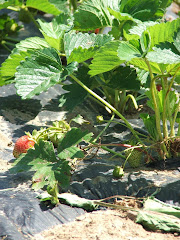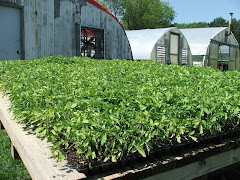This week's CSA bounty from One Straw Farm had several familiar vegetables - corn, green beans, Roma tomatoes, red leaf lettuce, and Anaheim hot peppers - as well as a few unexpected surprises including cantaloupe and Thai basil. Many people were unfamiliar with the Thai basil, an aromatic and sweet basil that carries warm notes of anise and pepper. Although it works well in any curry, stir-fry, soup or salad, having Thai basil on hand is a wonderful excuse to find some rice paper wrappers and make fresh Vietnamese spring rolls.
Preparing spring rolls can seem like a daunting task, but after making them once you may be surprised at the simplicity of this versatile recipe. They are substantive yet refreshing, and they make for great pot luck dishes or dinners when it's too hot to cook. Rolling spring rolls is also a great way to gather family and friends around the table. The key to success with spring rolls is to prep all ingredients before you commence with the rolling, and to give yourself plenty of space to spread out.
This recipe has been adapted from an excellent photo tutorial by Todd Porter and Diane Cu at the blog "White On Rice Couple," http://whiteonricecouple.com/recipes/how-roll-fresh-spring-rolls/. Their step-by-step photo instructions are definitely worth a look.
Step 1: Gather Your Ingredients
Once you get the hang of making spring rolls you can vary the ingredients according to your tastes and what you have on hand, but the essential ingredients are 1) rice paper wrappers 2) vegetables 3) herbs and 4) optionally, hearty fillings such as vermicelli noodles, grilled mushrooms, or cooked shrimp.
A sample ingredients list for 15 simple vegetarian spring rolls would look like this:
 |
| Photo credit: http://whiteonricecouple.com/recipes/how-roll-fresh-spring-rolls/ |
Preparing spring rolls can seem like a daunting task, but after making them once you may be surprised at the simplicity of this versatile recipe. They are substantive yet refreshing, and they make for great pot luck dishes or dinners when it's too hot to cook. Rolling spring rolls is also a great way to gather family and friends around the table. The key to success with spring rolls is to prep all ingredients before you commence with the rolling, and to give yourself plenty of space to spread out.
This recipe has been adapted from an excellent photo tutorial by Todd Porter and Diane Cu at the blog "White On Rice Couple," http://whiteonricecouple.com/recipes/how-roll-fresh-spring-rolls/. Their step-by-step photo instructions are definitely worth a look.
Step 1: Gather Your Ingredients
Once you get the hang of making spring rolls you can vary the ingredients according to your tastes and what you have on hand, but the essential ingredients are 1) rice paper wrappers 2) vegetables 3) herbs and 4) optionally, hearty fillings such as vermicelli noodles, grilled mushrooms, or cooked shrimp.
A sample ingredients list for 15 simple vegetarian spring rolls would look like this:
- 1 packet of rice paper wrappers, found in the international section of your supermarket or at Asian grocery stores. They come in dry sheets and will be soaked in water to become pliable before rolling.
- 1 packet of vermicelli noodles. You may see these packaged as rice vermicelli noodles or bean thread noodles, and they can also be found in international sections or Asian grocery stores. These will need to be cooked before rolling, and you can omit them if you prefer rolls with more vegetables.
- 1 head of large-leaf lettuce (such as the bunch of red leaf lettuce that came with this week's CSA)
- 2 large cucumbers
- 2 large carrots
- 1 cup of fresh mung bean sprouts (not necessary if you can't find them, but they add a nice crunch)
- 1 bunch of Thai basil
- 1 bunch of cilantro or mint
Step 2: Prep your cooked and cold ingredients
If you've recruited some friends to help you, this is a good time to divide and conquer. Set each ingredient into its own bowl or plate and lay the bowls out on the large kitchen table or counter where you will roll.
- Vermicelli noodles: These are so thin that they barely need to be cooked. Bring a pot of water to a near-boil, add the noodles (half or a quarter of the package will be enough) and cover, turn the heat off, and let the noodles soak in the hot water for 5-10 minutes. Once they are soft, rinse and drain them under cold water to prevent clumping, and then take a pair of kitchen scissors and cut the noodles into 2-3 inch sections.
- Lettuce: Wash and tear the lettuce into medium-sized pieces.
- Cucumbers and carrots: Peeled or unpeeled is your decision. Cut these into thin matchsticks.
- Bean sprouts: Just rinse these and leave them whole.
- Herbs (basil, cilantro, and /or mint): Rinse the herbs and then pinch off the leaves so that they are ready to be placed in the rolls.
Step 3: Roll!
Todd and Diane's photo tutorial is helpful here when you're first learning. The steps are 1) soak the rice paper 2) load up your ingredients and 3) roll!
The trickiest part is soaking the rice paper wrappers. Todd and Diane recommend soaking each wrapper in warm water for 2 seconds before rolling. It may take longer - up to a minute - for your wrappers to become pliable and translucent. A pie plate or other flat-bottomed dish works well here to hold the water.
Once you soak your wrapper and lay it out, load up your ingredients: a little bed of lettuce, a thin line of vermicelli, a few matchsticks each of the cucumber and carrot, a few bean sprouts, a few leaves each of the fresh herbs, and any other ingredients you're using. Lay the ingredients out in a thin rectangular shape close an inch or two away from the bottom of the wrapper (whichever edge is closest to you).
When you're ready to roll, tuck the bottom of the wrapper up and over the filling. Then tuck the left and right sides of the wrapper in so that the filling is in a little rice paper packet, and roll the filling away from you. The stickiness of the soft rice paper can be tricky to work with, but this is what helps to keep the roll closed.
Step 4: Enjoy!
Spring rolls can be eaten plain, but are also wonderful with hoisin sauce or a sweet chili sauce. You can buy a decent sweet chili sauce at most grocery stores, but if you're feeling adventurous you can also concoct your own. Fresh spring rolls are best when eaten right away but will last for a day or two in the fridge, making for easy leftover lunches. Try to leave a little space between rolls if you're storing them for any amount of time, as they can stick together. And if you have leftover rice paper wrappers and vermicelli, you can make these rolls again with the fresh vegetables and herbs from your next CSA share!






1 comment:
This is gorgeous!
Post a Comment